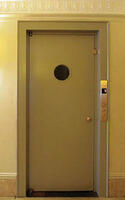HABITAT
Regenerative Elevator Drives
June 21, 2010 —When it comes to going green in your building, most co-op and condo boards and management companies immediately think of energy-guzzlers like lights and boilers. But there's another. unlikely source of untapped energy savings in many condo and co-op buildings: your elevators. New technology called a "regenerative elevator drive" can recapture some of the energy typically wasted in day-to-day operations.
Wayne Locker, director of technical support and field education for Transel Elevators says there are three ways that an elevator loses energy and a "regen" drive saves it:
(1) Loss: Anytime the elevator slows down, energy is created. In a typical elevator system, that energy is dissipated as heat through a device called a heat resister.
Gain: With a regen drive, the energy is captured and sent back to the power grid.
(2) Loss: Whenever an empty or lightly loaded elevator goes up, the motor spins but the elevator's counterweight does most of the work.
Gain: A regen drive can allow the motor to essentially act as a generator, creating power that also goes back to the grid.
(3) Loss: When a heavy elevator goes down, the motor spins but gravity is doing most of the work.
Gain: A regen drive can again generate power to the grid.
Locker says a regen drive allows a building to use less power, but that it's hard to estimate how much — that depends on the height of the property, the frequency of elevator use and the age of the equipment. Generally, he says, a regen drive can lead a building to use between 20 and 40 percent less electricity to power elevators. And while elevators in a residential building amount to only about five percent of total energy use, he estimates, savings can also come from the fact that if the energy isn't dissipated as heat, the equipment rooms don't have to be cooled as much as with a typical elevator system.
How Much Savings?
Ricky Williams, new business development director for Computerized Elevator Control Corporation, agrees that the energy savings vary; he estimates with reggen, you'd use 15 to 40 percent less energy to power elevators. Williams referred to a regen project installed in a New York City commercial building where the cost to operate the 28-story building's seven elevators was reduced by $5,800 one year after a modernization and regeneration project was completed.
How much a regen drive system can cost can also have a huge range, based on a wide variety of factors, says Williams. It depends on the type of system installed, the existing condition of the elevators, the size of the building, and the demand. Parts alone can cost between $7,000 and $12,000 per elevator.
Lewis Kwit, president of the energy consulting firm Energy Investment Systems, is helping clients who are contemplating regen drives in at least five different city condos and co-ops. "No one really knows how much energy the elevators actually use," he says. Kwit is installing data-loggers to track elevator usage in order to help co-op and condo boards decide if regen drives are worth it and what technology to install.
In one rental building, Kwit says, a simulation model showed that regen drives would not save enough energy to make them economically viable. But the data that tracked actual energy usage showed that the elevators consumed four times more energy than the simulation indicated. "You have to look at the real numbers so we can evaluate the cost effectiveness of the system," he says.
One of the buildings considering regen drives with Kwit's company is 201 East 66th Street, a 256-unit co-op with three elevators. Jon Shechter, on-site manager of the self-managed property, says the building is looking into a variety of upgrades, from regen drives to changing the motor systems of the elevators so that they can operate on the AC current that comes into the building, instead of the DC current many elevators use.
"First we have to see how much energy our elevators really use," he says. If the building decides to go with regen drives as part of its elevator upgrade, it would probably pay for them out of a combination of measures, perhaps combining funds from reserves, financing and assessments.
Kwit and other elevator and energy experts say that regen drives can be installed in existing elevators without upgrading overall systems. But he points out that some city elevator codes will be changing in 2011 to comply with more stringent safety requirements. "Many co-ops and condos will have to upgrade their elevators anyway," he says. "If they have to spend $150,000 to upgrade, adding another $20,000 or $40,000 is not going to be as big of a stretch."
Next page: Government incentives?




